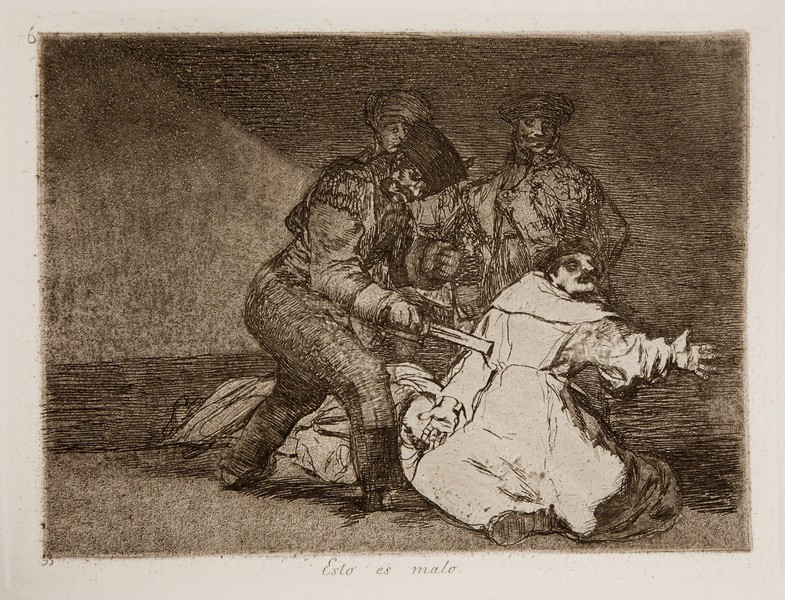- Cronología
- Ca. 1812 - 1815
- Dimensiones
- 156 x 208 mm
- Técnica y soporte
- Aguafuerte, aguatinta bruñida, punta seca, buril, lavis y bruñidor
- Reconocimiento de la autoría de Goya
- Undisputed work
- Ficha: realización/revisión
- 14 Dec 2010 / 28 Oct 2022
- Inventario
- 225
53 (on the lower left-hand corner of the plate) .
See Sad presentiments of what must come to pass.
The title was handwritten on the print by Goya in the first and only series that is known to have been printed at the time the works were created, which the artist gave to his friend Agustín Ceán Bermúdez. Therefore, the title was etched into the plate at a later date and left unchanged as of the first edition of the Disasters of War printed by the San Fernando Royal Academy of Fine Arts in Madrid in 1863, after the printing of the series in the possession of Ceán Bermúdez.
There are no surviving preparatory drawings for this print.
Under the cover of darkness, three French soldiers have entered a monastery and killed a monk who is lying on the ground. In the foreground, a French soldier wearing a concentrated, enraged expression runs his sword through the white habit of another monk whose face is distorted with pain. The monk spreads his arms in the gesture of one who does not fear death, similar to that made by the woman in print no. 26, One cannot look at this (No se puede mirar). The scene takes place before the entirely indifferent, almost complacent gaze of two more soldiers.
In this print, Goya, who in other works criticizes certain attitudes of the clergy, openly repudiates the brutal act taking place with the title This is bad. The spitefulness of the killing is heightened by the dark atmosphere which is penetrated by a beam of light that enters the composition from the left-hand side. It is possible that the monk was surprised as he slept in his cell, the light entering through the open door with the same violence as the French soldiers.
The artist has used etching in abundance on the right-hand side of the print, recreating the shadows with dense horizontal lines penetrated only by the light, expressed by a triangle of aquatint.
During the Spanish War of Independence, it was relatively common for French troops to enter and attack monasteries. Enrique Lafuente Ferrari mentions various significant massacres of monks, including those that took place at Rioseco, Uclés, Cuenca and Valencia.
This print is linked with the following, no. 47, This is how it happened (Así sucedió) in which another monk is the victim of a brutal attack.
The plate is stored in the National Chalcography (cat. 297).
-
Francisco de GoyaMuseo d'Arte ModernaLugano1996exhibition celebrated from September 22nd to November 17th.cat. 46
-
Francisco Goya. Sein leben im spiegel der graphik. Fuendetodos 1746-1828 Bordeaux. 1746-1996Galerie KornfeldBern1996from November 21st 1996 to January 1997cat. 130
-
Goya. Opera graficaPinacoteca del Castello di San GiorgioLegnano2006exhibition celebrated from December 16th 2006 to April 1st 2007p. 74
-
Goya et la modernitéPinacothèque de ParisParís2013from October 11st 2013 to March 16th 2014cat. 85
-
Goya, grabadorMadridBlass S.A.1918cat. 148
-
Goya engravings and lithographs, vol. I y II.OxfordBruno Cassirer1964cat. 166
-
Vie et ouvre de Francisco de GoyaParísOffice du livre1970cat. 1068
-
Catálogo de las estampas de Goya en la Biblioteca NacionalMadridMinisterio de Educación y Cultura, Biblioteca Nacional1996cat. 254
-
ParísPinacoteca de París2013p. 142
-
Goya. In the Norton Simon MuseumPasadenaNorton Simon Museum2016pp. 114-151
